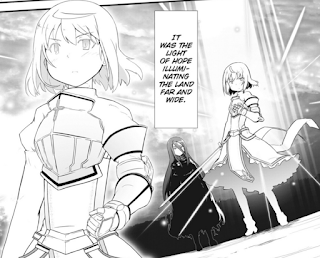One of my favorite urban fantasy tropes is when historical events are referenced, with the twist that there was actually something supernatural/fantastical going on; the Percy Jackson books and NBC's Grimm being two of my favorite works of fiction to do this. In the 2011 Japanese animated series Puella Magi Madoka Magica, it is revealed in the second-to-last episode that numerous girls throughout history were Magical Girls, and that their wishes built the foundation of modern civilization, albeit at a price. One such girl was Joan of Arc; Tart Magica is her story.
(Spoiler Warning: This review assumes you've already seen the original anime.)
Illustrated by Masugitsune and Kawazu-ku, with a story by the original creators of Madoka Magica, Tart Magica begins properly in 1425 in Domremy, France. Jeanne Tart, after spending some time praying in church, follows a fairy into the woods, only to be attacked by soldiers who have been possessed by a Witch, which in the Puella Magiverse are inhuman entities that spread curses throughout the world. She is saved by a mysterious girl named Riz, and meets a strange creature named Cube, who states that it has been seeking Tart out, offering to grant any wish she has in exchange for her becoming a Magical Girl, tasked with defending humanity from Witches. With the English encroaching on France, and war brewing, Tart joins Riz and Cube to lead France to victory in the Hundred Years' War.
(Tart in her Magical Girl armor, with Riz next to her.)
Tart Magica jumps into the action assuming the reader has already seen the original anime, beginning in media res with a battle between Tart's Magical Girl squad and a team of English Magical Girls; in the course of the battle, one of the English Magical Girls falls, and her team leader, deeming her no longer useful, forcefully turns the former into a Witch, immediately spoiling the show's twist that Witches are in fact mutated Magical Girls. What was originally a horrifying revelation showing how cruel and inhuman Kyubey and the Incubators are is treated as something that should be common knowledge (indeed, Tart learns before the volume is over that this is the origin of Witches). While spoiler-heavy for those who have never watched Madoka Magica, it also signals that this prequel will not fall back on the same plot points of the show (innocent girl meets Kyubey, learns horrifying truth about Magical Girls, etc.), opening up numerous possibilities for where the plot can go, the introduction of an antagonistic Magical Girl team being one of them.
(The leader of the English Magical Girls forces her fallen teammate to become a Witch.)
In terms of characterization, the first volume uses the standard dynamic of the naïve newcomer paired with the experienced figure who can guide them through the new world they've stumbled upon. Tart is portrayed as an idealistic young girl whose faith in God is firm, to the point that she takes Cube to be an angel. This character trait leads to her being easily-manipulated by Cube, who uses the right combination of words to convince Tart that she's doing a good thing by becoming a Magical Girl; while it can be easy to say she is too naïve, the blame is really more on Cube for taking advantage of her innocence in order to further its own agenda. Riz, meanwhile, is Tart's loyal friend, and a bit aloof; fittingly enough, her powers are tied to shadows and darkness, and she uses a scythe. As a brooding, long-haired girl dedicated to working with the story's innocent protagonist, she bears more than a passing resemblance to Homura Akemi, but she is still an interesting character, especially given how little is said about her past at this point.
(Riz's Character Profile.)
The end of the manga also features an essay and notes detailing some of the research done while writing Tart Magica, with the promise of listing a complete bibliography in the final volume. The research done is evident in the amount of info-dumps scattered throughout the story; while they may be a bit dense for someone who was expecting a fast read, they are very fascinating, especially when taking into account how the story mixes history and fantasy. It is definitely right up there with other works of historical fiction/fantasy in terms of research done and care taken to the actual events.
(Endnote on the village of Domremy, including information about the fabled Fairy Tree.)
Puella Magi Tart Magica is a well-written piece of historical fantasy, albeit one that is better appreciated if read by those familiar with Madoka Magica. Given how infamous the original series has become due to its leaning towards dark and gritty fantasy/horror, it is pleasantly surprising how lighthearted this first volume is; that being said, it is worth remembering that even the original anime started out fairly light, before the darker undertones began to surface. That being said, Tart Magica does a good job in its first volume getting readers to care about where the story is going, regardless of the foregone conclusion and overall bleakness of the larger setting. It's worth checking out.





No comments:
Post a Comment